Your cells regenerate their energy systems through a complex but efficient process centered around ATP (adenosine triphosphate). When you need energy, your mitochondria work as cellular powerhouses, breaking down glucose through glycolysis and using oxygen in the electron transport chain. These processes create ATP molecules, which act like tiny rechargeable batteries for your cells. Your body constantly maintains this energy cycle through both quick-response systems like phosphocreatine and long-term storage methods involving glucose metabolism. Advanced cellular mechanisms guarantee you'll always have energy ready when you need it, and there's much more to discover about these fascinating biological processes.
ATP: The Cellular Energy Currency
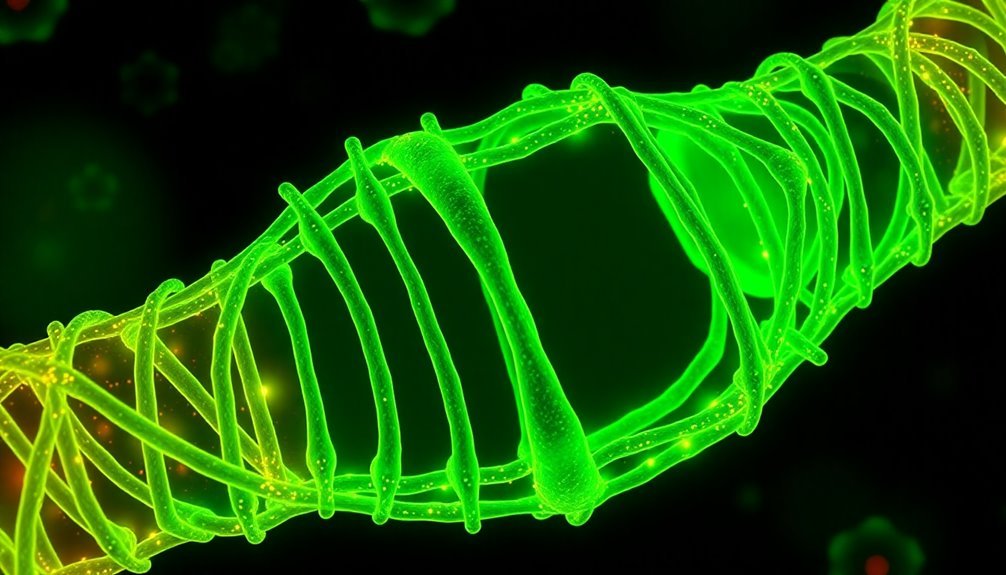
At the heart of cellular function lies ATP (adenosine triphosphate), a remarkable molecule that serves as the universal energy currency in living cells. You'll find this nucleotide composed of adenosine bonded to three phosphate groups, storing energy in its phosphoanhydride bonds.
When your cells need energy, ATP releases it through hydrolysis, breaking down into ADP and inorganic phosphate. Under standard conditions, ATP hydrolysis releases 7.3 kcal/mol of energy, but in cellular conditions, this can increase to 14 kcal/mol. The process is facilitated by ATPase enzymes that catalyze the breakdown reaction.
You'll see this energy driving crucial cellular processes through a mechanism called energy coupling. When ATP transfers its phosphate groups to other molecules, it enables both endergonic and exergonic reactions that wouldn't occur spontaneously.
Your cells maintain a constant supply of ATP through continuous recycling. When ATP breaks down to power cellular work, it's quickly regenerated through cellular respiration in the mitochondria.
This efficient system guarantees you're never without energy for essential processes like ion transport through the sodium-potassium pump. Through sophisticated regulatory mechanisms, your cells maintain ideal ATP levels by adjusting production based on energy demand and substrate availability.
Mitochondrial Power Generation Systems
The remarkable ATP production you've just learned about happens within the powerhouses of your cells – the mitochondria. These sophisticated organelles feature a double-membrane system, with the inner membrane serving as the primary site for ATP synthesis. Through oxidative phosphorylation (OXPHOS), your mitochondria can generate over 30 ATP molecules from a single glucose molecule.
Your cells' energy production relies on the electron transport chain (ETC), which transfers electrons between four major complexes in the inner mitochondrial membrane. The cristae membrane plays a vital role in this process, while mitochondrial supercomplexes enhance electron transfer efficiency. Specifically, the most abundant supercomplex in mammals consists of complexes I + III + IV, organized through phospholipid interactions.
You'll find that mitochondria can even pause in areas of high metabolic demand to provide localized energy production.
Recent technological advances have opened new possibilities for enhancing mitochondrial function. Scientists have developed molybdenum disulfide nanoflowers that can stimulate mitochondrial regeneration and boost ATP production.
They've also created bio-inspired devices that mimic cellular respiration using mitochondria and red blood cells, achieving impressive power density levels. These innovations could lead to treatments for various diseases and advance sustainable energy technologies.
Glucose Breakdown and Energy Release
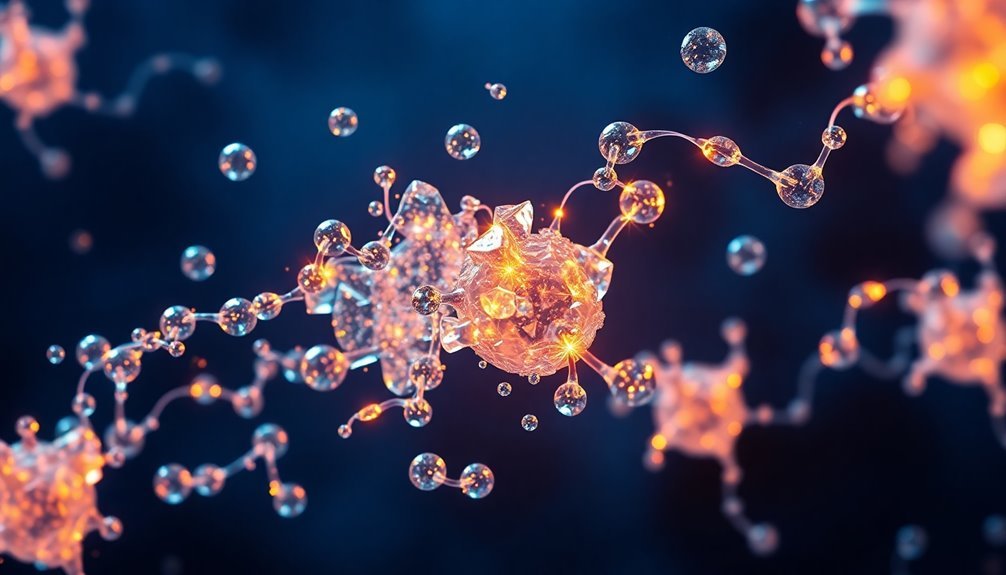
You'll discover that glucose breakdown starts with glycolysis, where a single glucose molecule splits into two pyruvate molecules while producing 2 ATP and 2 NADH in the cell's cytosol.
Just as system monitoring tools help identify energy issues, your cells have sophisticated mechanisms to detect and respond to energy needs. Your cells then transfer these pyruvates to the mitochondria, where they enter the citric acid cycle to generate electron carriers like NADH and FADH2.
These electron carriers power the electron transport chain in the mitochondrial membrane, creating most of your cell's ATP through a complex but efficient energy transfer system that yields about 30 ATP molecules per glucose.
Glycolysis Pathway Steps
Inside every living cell, glycolysis breaks down glucose through a series of ten enzymatic steps to produce energy. The pathway splits one glucose molecule into two pyruvate molecules while generating ATP and NADH. You'll find this process occurring in the cytoplasm, where specific enzymes like hexokinase catalyze each conversion step.
The pathway's first half requires energy investment, using two ATP molecules to prepare glucose for cleavage. However, the second half rewards your cells with energy-releasing steps that produce four ATP molecules, resulting in a net gain of two ATP. Understanding how substrate-level phosphorylation directly produces ATP is crucial for cellular energy production. You'll notice that NAD+ plays an essential role, as it's converted to NADH during the oxidation of glyceraldehyde-3-phosphate.
- Step 6 through 7 involves oxidation and substrate-level phosphorylation, producing NADH and ATP.
- Steps 8 and 9 transform 3-phosphoglycerate through isomerization and dehydration.
- Step 10 generates the final ATP molecule and pyruvate.
- NAD+ regeneration occurs through the electron transport chain or fermentation.
This universal process guarantees your cells maintain their energy supply, whether in the presence or absence of oxygen, making it fundamental for cellular survival.
ATP Production Chain
Throughout your body's cells, ATP production flows down a remarkable chain of events, transforming glucose into usable energy through three major stages.
You'll find this process starts with glycolysis, moves through the Krebs cycle, and culminates in the electron transport chain, where most of your ATP is generated.
The electron transport chain, embedded in your mitochondria's inner membrane, is where the real energy magic happens. Here, electron carriers NADH and FADH2 transfer their cargo along a series of proteins, creating a proton gradient that powers ATP synthesis. Oxygen serves as the final electron acceptor, forming water as a byproduct of this process.
You're getting the most bang for your buck in this stage, as it produces up to 34 ATP molecules per glucose molecule.
While you'd theoretically get 38 ATP molecules from one glucose molecule, you'll actually end up with about 28-30 due to natural inefficiencies.
Your cells maintain tight control over this process through feedback mechanisms – when ATP levels rise, production slows down, and when they fall, it speeds up.
This continuous cycle of ATP consumption and regeneration keeps your cells running efficiently, powering everything from active transport to biosynthesis of essential molecules.
Energy Transfer Mechanisms
The remarkable process of glucose breakdown drives your cells' energy production through a precise chemical equation: C₆H₁₂O₆ → 6H₂O + 6CO₂. Your cells use this process through both aerobic and anaerobic respiration, with aerobic respiration yielding considerably more ATP for your cellular functions.
ATP serves as your cells' energy currency, linking the breakdown of glucose to the power needed for cellular work. When ATP hydrolyzes, it releases energy by breaking down into ADP and inorganic phosphate. Your cells then continuously regenerate ATP by reattaching phosphate groups using energy from glucose metabolism. The Citric Acid Cycle in the mitochondrial matrix helps generate energy carriers needed for ATP production.
- Your cells rely on oxidative phosphorylation for 90% of ATP production
- The process occurs in mitochondria (eukaryotes) or plasma membrane (prokaryotes)
- Energy transfer happens through chemiosmosis, using electrochemical gradients
- ATP regeneration involves both substrate-level and oxidative phosphorylation
The continuous cycle of ATP breakdown and regeneration keeps your cells functioning. Through this sophisticated energy transfer system, glucose catabolism powers the conversion of ADP back to ATP, ensuring a steady supply of energy for all your cellular processes.
Electron Transport Chain Mechanics
A complex series of molecular machinery drives the electron transport chain within your mitochondria's inner membrane. Five distinct protein complexes work together to generate the energy your cells need, with each complex playing a vital role in the process.
You'll find that NADH and FADH2 serve as electron donors, initiating the chain reaction at complexes I and II. As electrons move through these complexes, they release energy that's used to pump protons from the matrix into the intermembrane space. This creates a proton gradient that's essential for ATP production. At the end of the chain, molecular oxygen serves as the final electron acceptor.
Think of it as building up pressure that your cells can later use. When the protons flow back through complex V (ATP synthase), they drive the production of ATP from ADP.
Your cells carefully regulate this process. When ATP levels rise too high, production naturally slows down. Conversely, high ADP levels signal your cells to ramp up ATP synthesis.
It's worth noting that this system isn't perfect – sometimes electrons leak out, forming potentially harmful free radicals. Additionally, certain proteins can uncouple the process, converting the energy to heat instead of ATP, which is particularly important in brown fat tissue.
Oxygen's Role in ATP Production
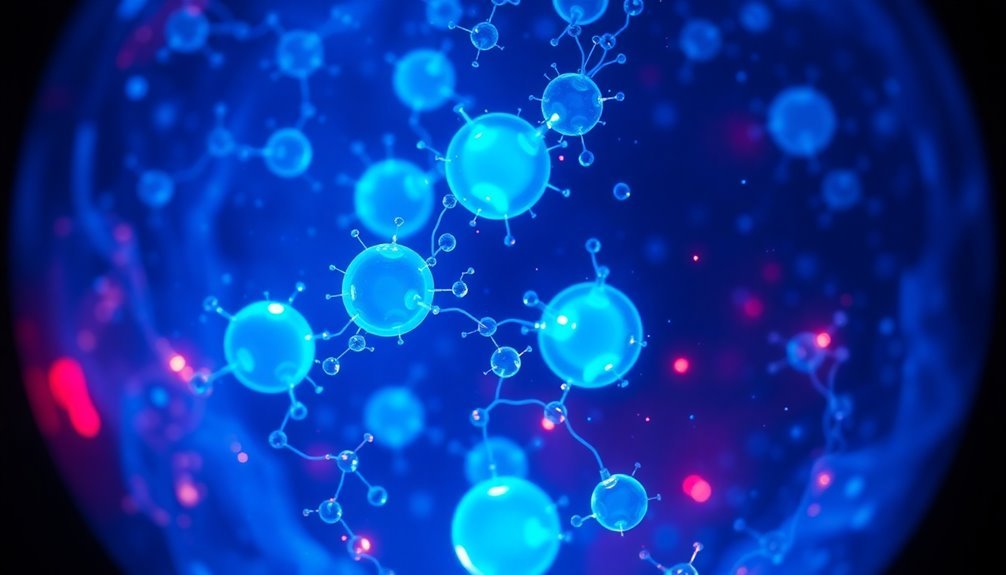
Building on the intricate mechanics of the electron transport chain, oxygen plays a central role in powering your cells' energy production. The inner mitochondrial membrane houses these crucial processes. As the final electron acceptor in cellular respiration, oxygen combines with electrons and hydrogen ions to form water, enabling the continuous flow of energy production.
Without oxygen, your cells can't complete the electron transport chain process, which would bring ATP production through chemiosmosis to a halt.
Through oxidative phosphorylation, oxygen helps your cells maximize energy production from glucose. When you breathe in oxygen, you're supplying your cells with the crucial component they need to generate up to 36 ATP molecules from a single glucose molecule. This process is considerably more efficient than anaerobic respiration, which produces far less ATP.
- Oxygen combines with electrons and H+ ions to form water, releasing energy for ATP production
- Your cells use oxygen to create a proton gradient that drives ATP synthesis
- Each glucose molecule can yield approximately 29-30 ATP through aerobic respiration
- Without oxygen, cellular energy production dramatically decreases, potentially leading to cell death
Through this oxygen-dependent process, your cells maintain their energy supply and continue performing essential functions necessary for survival.
Energy Storage Through Phosphate Bonds
Inside your cells, phosphate bonds serve as tiny molecular batteries that store and release energy on demand. When you need energy for any cellular activity, your cells break down ATP (adenosine triphosphate) through hydrolysis, separating it into ADP and an inorganic phosphate ion. This breakdown releases energy that your cells can immediately use for essential functions like muscle contraction and active transport.
During these vital reactions, electron carriers like NAD transport high-energy electrons between compounds to facilitate energy production. You're constantly using ATP, so your cells need an efficient way to regenerate it. They accomplish this through glucose metabolism, primarily using two processes: glycolysis and oxidative phosphorylation.
During these processes, your cells harness energy from glucose to reattach phosphate groups to ADP, creating new ATP molecules.
Think of ATP as your cells' universal energy currency. While glucose serves as your long-term energy storage, ATP provides instantly accessible energy.
Your cells maintain a delicate balance through continuous ATP breakdown and regeneration. This system is remarkably efficient – through aerobic respiration, a single glucose molecule can produce multiple ATP molecules, ensuring you'll have enough energy for all your cellular activities.
Cell-Free ATP Regeneration Methods
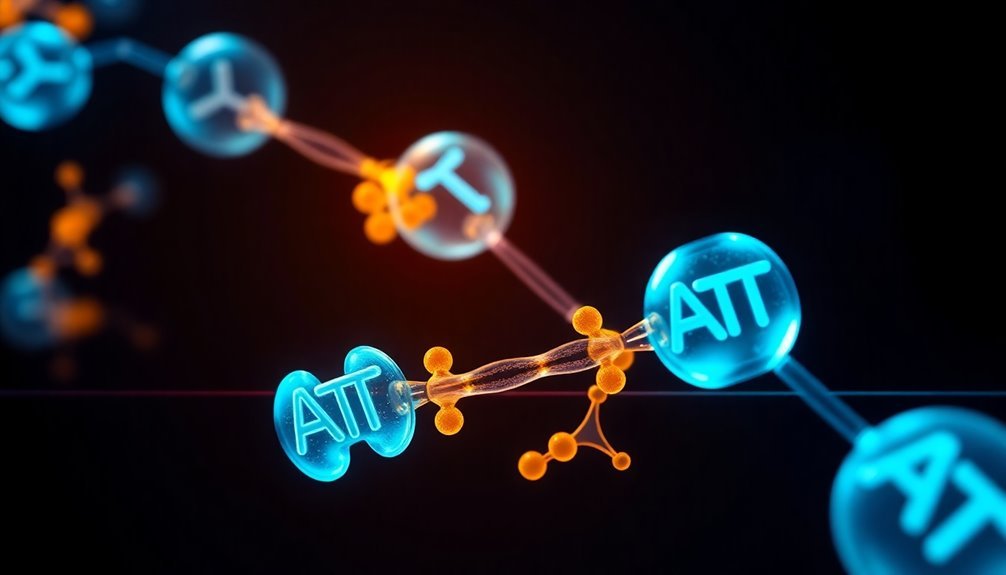
Beyond living cells, scientists have developed innovative methods to regenerate ATP in cell-free environments, primarily to support protein synthesis reactions. You'll find that these systems use either substrate-level phosphorylation or multienzyme reaction cascades to maintain ATP levels while reducing inorganic phosphate accumulation.
Traditional methods rely on high-energy phosphate donors like PEP and creatine phosphate, but they're expensive and require cold storage. That's why researchers have turned to more cost-effective alternatives like maltodextrin, which can regenerate ATP through oxidative phosphorylation and enhance protein production when combined with other energy sources. This approach has achieved remarkable results, with some systems maintaining protein synthesis for up to 6 hours and producing substantial yields.
- Substrate-level phosphorylation uses compounds with high-energy phosphate bonds
- Multienzyme cascades mimic natural metabolic pathways like glycolysis
- Polyphosphate kinase 2 systems provide sustainable ATP regeneration
- Novel energy sources like maltodextrin offer more stable, affordable solutions
Recent advances have introduced innovative systems like PANOxSP and cytomim, which provide continuous chemical energy supply.
You'll also see improvements in preventing phosphate accumulation, which helps extend protein synthesis reaction duration. These developments have made cell-free ATP regeneration more practical and efficient for various applications.
Light-Activated Energy Production Pathways
While cell-free ATP regeneration methods offer significant benefits, scientists have discovered an even more innovative approach through light-activated energy production in living cells. This groundbreaking technique uses optogenetic tools to equip mitochondria with light-activated proton pumps, fundamentally installing cellular solar panels that can harness light energy to produce ATP.
You'll find this process, known as mtON, works by genetically modifying mitochondria to respond to light exposure. When activated, these specialized proton pumps increase the membrane potential across mitochondrial membranes, boosting ATP production. The results are remarkable – in studies with roundworms, this modification led to a 30-40% increase in lifespan.
The implications of this technology extend far beyond basic research. You can see its potential in treating mitochondrial diseases, where dysfunctional energy production causes serious health issues.
The system works alongside natural energy pathways like glycolysis and oxidative phosphorylation, complementing your cells' existing energy production mechanisms. Scientists are now exploring applications in cancer treatment, neuronal development, and stem cell research, where precise control over energy production could revolutionize therapeutic approaches.
Metabolic Energy Conservation Strategies
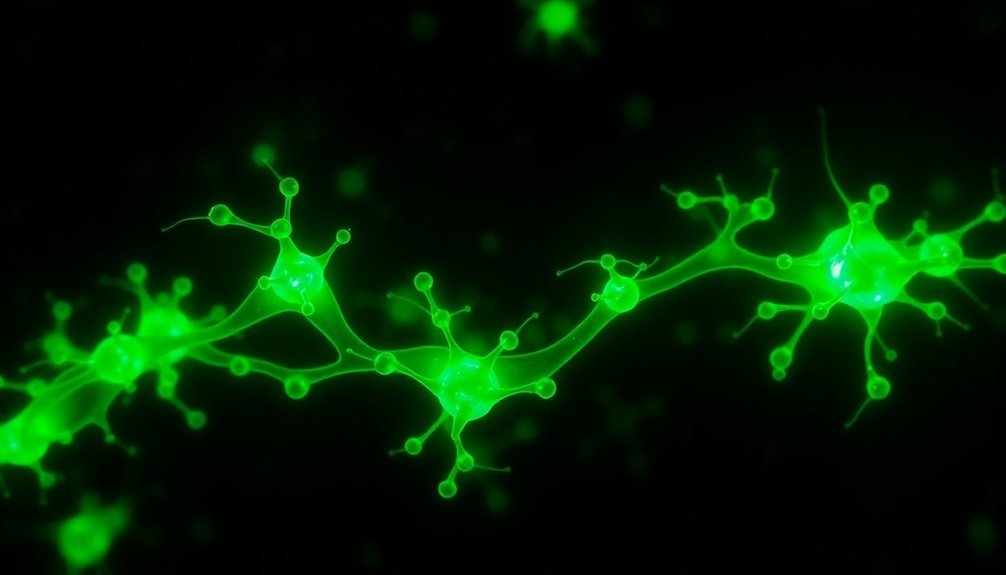
Your cells rely on sophisticated ATP regeneration pathways like oxidative phosphorylation and glycolysis to maintain a constant energy supply.
You'll find these processes working together as an integrated system, where glucose metabolism powers the continuous regeneration of ATP from ADP and phosphate.
Your cellular machinery cleverly conserves energy through these pathways, functioning much like a rechargeable battery system that efficiently meets your body's ongoing energy demands.
ATP Regeneration Pathways
Living cells carry out complex ATP regeneration pathways to keep their energy levels stable and support essential functions. You'll find that glycolysis, occurring in the cytoplasm, initiates this process by generating ATP through substrate phosphorylation and producing NADH for further energy production.
When oxygen is present, the citric acid cycle and oxidative phosphorylation take over in the mitochondria, where they're responsible for producing most of your cells' ATP.
Beta-oxidation joins these pathways by breaking down fatty acids within the mitochondria, contributing additional NADH and FADH2 that can be converted to ATP.
You'll see that ATP regeneration relies heavily on the proton gradient across the mitochondrial membrane, which ATP synthase uses to create new ATP molecules from ADP and phosphate.
- Glycolysis produces initial ATP and NADH in the cytoplasm without requiring oxygen
- The citric acid cycle and oxidative phosphorylation generate the bulk of cellular ATP using oxygen
- Beta-oxidation breaks down fats to produce additional energy-carrying molecules
- ATP synthase uses the proton gradient to drive ATP production, while specialized shuttles and transporters maintain the system's efficiency
Energy Storage Mechanisms
Cellular powerhouses employ multiple strategies to store and conserve metabolic energy for future use. You'll find that cells primarily rely on high-energy phosphoanhydride bonds in ATP molecules as their immediate energy currency. When your cells need power, they'll break these bonds through ATP hydrolysis, coupling this energy release with other cellular reactions that require an energy boost.
For long-term energy storage, your cells utilize sophisticated pathways like glycolysis and oxidative phosphorylation. They'll also engage the pentose phosphate and serine synthesis pathways when they need to generate biomass for cell proliferation.
| Energy System | Impact on Your Cells |
|---|---|
| ATP Bonds | Powers immediate cellular reactions |
| Glycolysis | Provides quick energy access |
| Oxidative Phosphorylation | Generates peak energy yield |
| Fatty Acid Oxidation | Supplies sustained energy release |
| Pentose Phosphate Pathway | Supports cell growth and division |
Your cells don't work in isolation – they're constantly responding to external signals and nutrient availability through pathways like PI3K, mTOR, and HIF1α. These pathways help regulate energy storage and usage, ensuring your cells maintain ideal energy levels for survival and function.
Cellular Energy Recovery Mechanisms
Multiple mechanisms work together in cells to maintain and recover energy levels, with ATP regeneration at the heart of these processes. Your cells rely heavily on the phosphocreatine system, which acts as a rapid energy buffer by converting ADP back to ATP through creatine kinase enzymes. This process is essential because the limited diffusion of ATP in your cellular environment requires an efficient energy distribution system.
When you're experiencing energy stress, your cells activate several recovery pathways. SIRT1, a key regulator of cellular metabolism, helps maintain mitochondrial quality through biogenesis and mitophagy. Your cells also coordinate between mitochondrial and cytosolic energy production to guarantee peak energy recovery.
- The phosphocreatine shuttle system transfers high-energy phosphate from mitochondria to cytosol, enabling quick ATP regeneration where it's needed most.
- Different creatine kinase isoforms work at specific cellular locations, guaranteeing efficient energy distribution throughout your cells.
- Both anaerobic and aerobic pathways contribute to ATP regeneration, providing flexibility in energy recovery.
- NAD+ levels in your nucleus influence SIRT1 activity, which can be enhanced through NAD+ precursor supplementation to improve energy recovery.
Frequently Asked Questions
Can Cells Regenerate Energy Systems Faster Under Extreme Temperature Conditions?
No, you won't see faster energy regeneration in extreme temperatures. While moderate heat can increase reaction rates, extreme temperatures typically disrupt enzyme function and damage cellular machinery, reducing your cells' energy production efficiency.
How Do Aging Cells Maintain Their Energy Regeneration Capabilities?
You'll find aging cells maintain energy by relying more on glycolysis, adapting their metabolic pathways, and utilizing PI3K/AKT and mTOR signaling. They also respond to nutrient availability and growth factor stimulation.
What Role Do Hormones Play in Cellular Energy System Regeneration?
Your hormones regulate cellular energy regeneration by activating metabolic enzymes, controlling glucose levels, and stimulating ATP production. They're essential for maintaining energy balance and optimizing your cells' energy-producing pathways.
Do Different Tissue Types Have Varying Energy Regeneration Efficiencies?
Yes, you'll find that tissues vary considerably in energy regeneration efficiency. Your muscle and neural tissues are highly efficient due to abundant mitochondria, while connective tissues have lower efficiency with fewer mitochondria.
Can Environmental Toxins Permanently Damage Cellular Energy Regeneration Mechanisms?
Yes, environmental toxins can permanently damage your cells' energy regeneration systems. Through oxidative stress and mitochondrial dysfunction, toxins like pesticides and heavy metals can cause lasting impairment to your cellular energy production mechanisms.
In Summary
You've learned how cells maintain their energy through multiple interconnected systems. Your cells rely on ATP production through both aerobic and anaerobic pathways, with mitochondria serving as your cellular powerhouses. You'll find that glucose breakdown, electron transport chains, and oxygen all play essential roles in regenerating cellular energy. Whether through traditional metabolic processes or alternative pathways, your cells constantly work to maintain their energy balance.

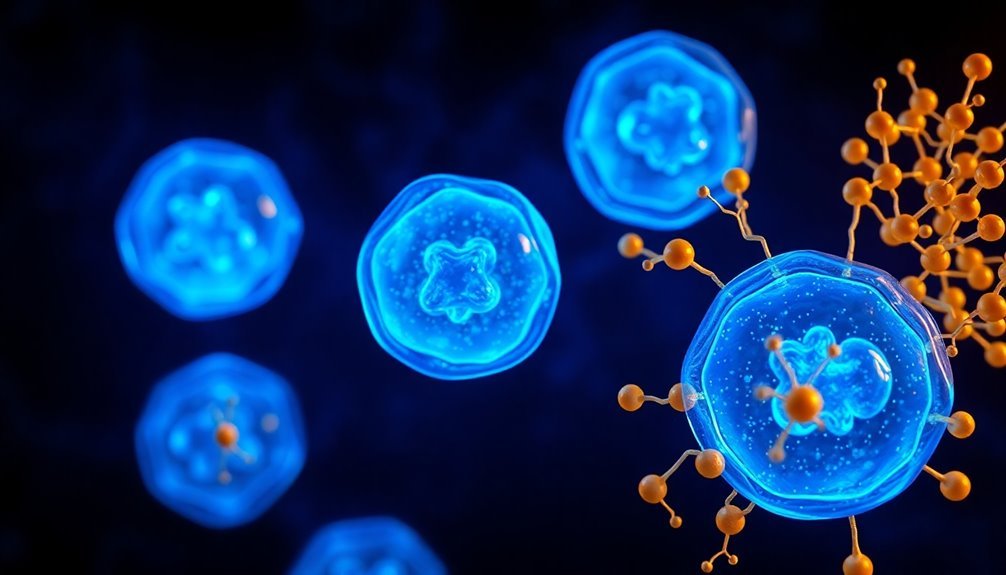



Leave a Reply